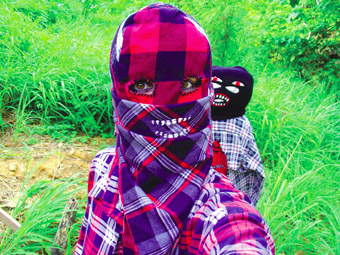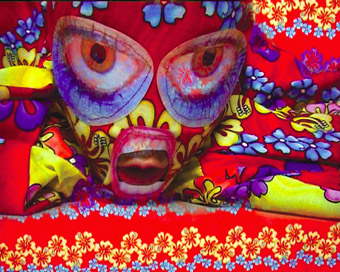mask play
victoria carless: jemina wyman video

Combat Drag (video still), 2008, Jemima Wyman
images courtesy the artist and Milani Gallery Brisbane 2009.
Combat Drag (video still), 2008, Jemima Wyman
It’s night (cam). You’re in the scrub, playing at bushrangers. A voice from the rough end of hell tells you, “It’s coming to get us.” Is this your big brother playing tricks, or something far more sinister?
In Jemima Wyman’s video work Combat Drag a small army of flannelette-clad forms stake out their territory. Like YouTube zealots they posture and pose with menace in out of the way places, waving twigs as if they were guns. These figures have an essence of the Monkey Magic ninja, but also of dispossessed Australian youths. In addition to the iconic flannie, the performers in Combat Drag wear exquisitely crafted woollen masks with sewn expressions—like those belonging to the slightly odd-shaped toys you can buy in gallery shops. Only the performers’ mouths and eyes are visible, enhancing a fearful sense of the unseen and unknown.
This work disconcerts by skewing the familiar. Cultural symbols, ideas about identity and images of extremism trip each over each other. The strange masks, ‘terrorists’ in flanelette, ambiguous setting and a disturbing voiceover alerting us to the approach of “something big and scary” collectively evoke a corporeal response. The fear we are meant to experience, nonetheless, feels contrived and ironic—we are told in no uncertain terms that we should be afraid.

Whak’emall (video still), 2006, Jemima Wyman
images courtesy the artist and Milani Gallery Brisbane 2009
Whak’emall (video still), 2006, Jemima Wyman
More menacing for me is the work titled Whak’emall, which features a figure somewhere between a tantrum-throwing toddler and another backyard terrorist. Masking is also featured in this work, with the toy-like puppet toddler/terrorist garbed in a vertigo-inducing hibiscus-printed coverall. This garment has a homemade quality about it: part pyjamas and part straitjacket. Here too, the headpiece is customized, this time with appliquéd facial features and a hole cut out for the performer’s mouth. Red squiggles suggest the bloodshot eyes of a character both temperamental and nightmarish.
At one point the performer spins the mask to reveal a similarly disturbing face on a yellow hibiscus background. The personality of the subject does not change, despite the disorienting shift in camouflage. Different factions adopt different guises but the militant ideology remains the same.
The construction of this video work has a calculated naivety, its visual and audio quality evoking a YouTube posting or sinister home video. Wyman aims to disarm us, using familiar techniques to frame her disturbing figures.
Whak’emall and Combat Drag evoke a subjective state where extremists—be they toy, toddler, suburban youth or terrorist—find a sense of belonging and achieve oneness by donning masks. But along the way, Jemima Wyman leaves plenty of gaps into which we may insert other meanings of our own.






